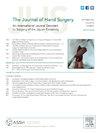Reliability and Validity of the Ten Test for the Assessment of Digit Sensation
IF 2.1
2区 医学
Q2 ORTHOPEDICS
引用次数: 0
Abstract
Purpose
The ten test (TT) is a sensory assessment used to quantify the sensation of each digit. Because it does not require additional equipment, it may have utility in telemedicine. Our purpose was to evaluate the validity and reliability of the TT.
Methods
Adult patients with nontrauma upper-extremity complaints were evaluated within an academic outpatient clinic. Two examiner groups (hand surgeons [group 1] and residents/physician assistants [group 2]) administered the TT and static two-point discrimination (2PD). Hand surgeons were blinded to the results obtained by the initial examiners. The TT is administered by having the patient define an area of normal sensation with their uninvolved index finger and then rate digital sensation against the involved hand on a 1–10 scale, with 10 defined as perfectly normal sensation. A cut-point analysis was employed, and both sensory assessments were categorized as either normal (2PD ≤5 mm, TT ≥9) or abnormal sensation for the entire median-nerve distribution and individual digit level. Agreement statistics including sensitivity (Sn) and specificity (Sp) were calculated for the TT, using static 2PD as the reference standard. Interrater reliability was compared between the groups of examiners.
Results
A total of 201 patients (1,005 digits) were examined. The Sn/Sp for the TT was 53%/84% and 54%/85% at the digit-level and median-nerve distribution level, respectively. Interrater reliability for the TT between the groups of examiners was substantial at the digit level (κ = 0.68, SE = 0.02).
Conclusions
The Sn/Sp for the TT was 53%/84% when using static 2PD as the reference standard. Interrater reliability for TT was substantial (κ = 0.68). The TT can serve as an alternative to other sensory assessments that require instrumentation. As telemedicine programs continue to evolve within upper-extremity surgery, the TT may be a useful tool with virtual applications.
Type of study/level of evidence
Diagnostic I.
手指感觉测验的信度和效度。
目的:十位测试(TT)是一种感官评估方法,用于量化每个数字的感觉。由于它不需要额外的设备,因此在远程医疗中可能很有用。我们的目的是评估 TT 的有效性和可靠性:方法:在一家学术门诊中对上肢无创伤的成年患者进行评估。两组检查人员(手外科医生 [第 1 组] 和住院医师/医生助理 [第 2 组])分别进行 TT 和静态两点辨别 (2PD) 测试。手外科医生对初始检查者得出的结果视而不见。TT的测试方法是让患者用未受累的食指定义一个感觉正常的区域,然后用1-10分对受累手的数字感觉进行评分,10分为感觉完全正常。采用了切点分析法,两种感觉评估均被归类为正常(2PD ≤5 mm,TT ≥9)或整个正中神经分布和单个手指感觉异常。以静态 2PD 为参考标准,计算了 TT 的一致性统计,包括灵敏度 (Sn) 和特异度 (Sp)。比较了各组检查者之间的相互可靠性:共检查了 201 名患者(1,005 个数字)。在数位水平和中位神经分布水平上,TT 的 Sn/Sp 分别为 53%/84% 和 54%/85%。在数位水平上,两组检查者之间的TT互测可靠性非常高(κ = 0.68,SE = 0.02):以静态 2PD 作为参考标准时,TT 的 Sn/Sp 为 53%/84%。TT 的互测可靠性很高(κ = 0.68)。TT 可以替代其他需要仪器的感官评估。随着远程医疗项目在上肢外科领域的不断发展,TT可能会成为一种有用的虚拟应用工具:诊断 I。
本文章由计算机程序翻译,如有差异,请以英文原文为准。
求助全文
约1分钟内获得全文
求助全文
来源期刊
CiteScore
3.20
自引率
10.50%
发文量
402
审稿时长
12 weeks
期刊介绍:
The Journal of Hand Surgery publishes original, peer-reviewed articles related to the pathophysiology, diagnosis, and treatment of diseases and conditions of the upper extremity; these include both clinical and basic science studies, along with case reports. Special features include Review Articles (including Current Concepts and The Hand Surgery Landscape), Reviews of Books and Media, and Letters to the Editor.

 求助内容:
求助内容: 应助结果提醒方式:
应助结果提醒方式:


